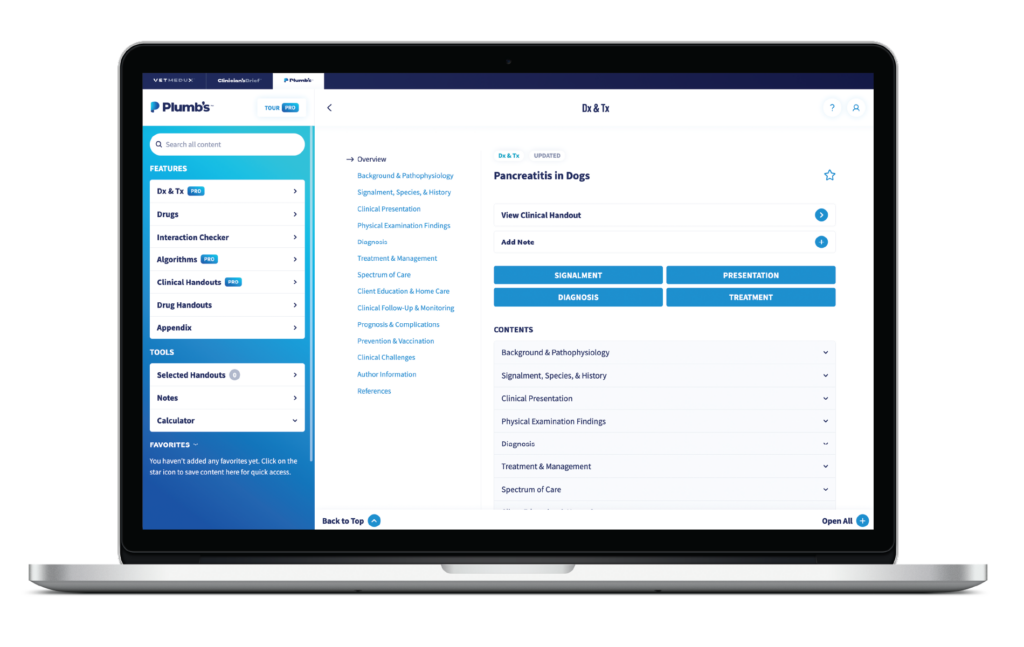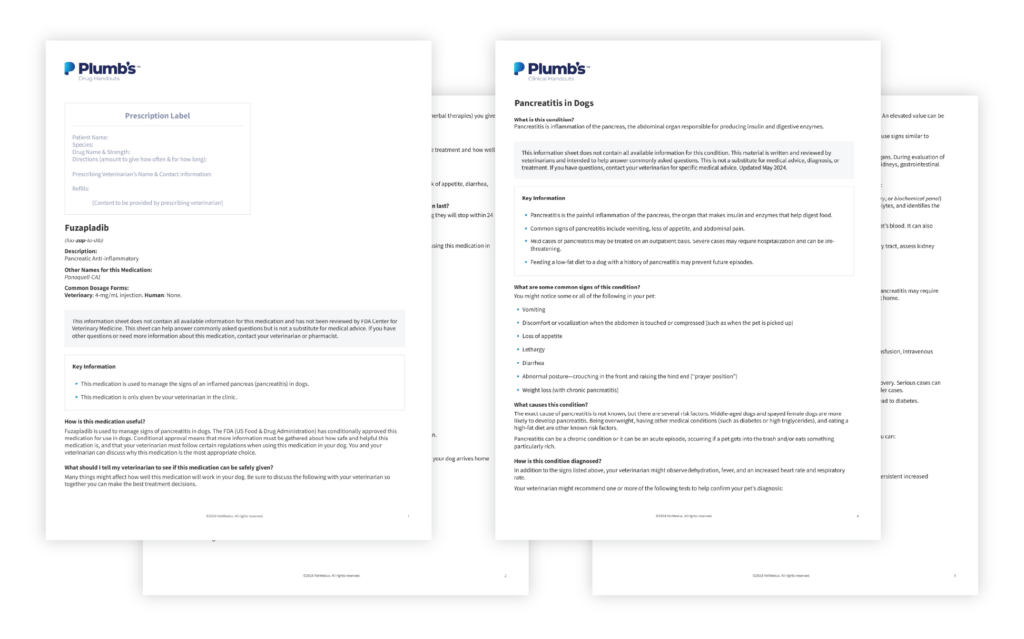No one could ever call veterinary medicine boring. It seems like every week brings new challenges and new breakthroughs. The moment you feel like you have a treatment protocol down, an innovative diagnostic test or groundbreaking new therapy arrives, and you start learning all over again. Whether you’re dealing with common conditions that don’t read the textbook or navigating more complex cases like pancreatitis in dogs, staying updated is crucial—but it can feel like a full-time job.
That’s where a clinical decision support tool like Plumb’s Pro™ comes in. It ensures that everything you need to make confident decisions for your patients—from drug details and veterinary client handouts to diagnostic and treatment information—is continually updated and accessible in seconds.
In this case, we’ll explore how Plumb’s Pro™ can help you stay current with the latest diagnostic and treatment information so you can confidently care for your patients.
Meet Your Patient and Pet Owner
Your patient today is Marley, an 8-year-old spayed female shih tzu mix weighing 7.1 kg. Marley’s energy levels have decreased over the past few days, and she hasn’t been interested in eating her kibble. Her owner, Heather, has been cooking chicken and ground beef to entice her to eat, but Marley isn’t interested in more than a few bites.
She vomited once yesterday and twice overnight last night. Heather is unsure about urination or bowel movements as Marley goes out into the yard unattended.
Marley has been healthy until now, though Heather states she tends to be a picky eater. To encourage her to eat, Heather will often top-dress Marley’s kibble with cheese or a few pieces of her own meal. Marley is up to date on vaccinations and parasite prevention, and there is one other dog in the home who appears healthy. Heather isn’t aware of any dietary indiscretions.
On physical exam, Marley has a body condition score of 7/9 and her temperature and respiratory rate are within normal limits. Her heart rate is slightly elevated and she is moderately uncomfortable on cranial abdominal palpation. Soft brown stool is present on rectal exam. No other abnormalities are found aside from mild periodontal disease.
Follow an Algorithm for Step-by-Step Diagnostic Support
You’d like to double-check the diagnostic steps for a patient with abdominal pain, so you turn to the acute abdominal pain algorithm in Plumb’s Pro™. You scan the list of suggested history questions to make sure you haven’t missed anything and then review the differential diagnoses.

You follow the recommendations for initial diagnostics and draw blood for a complete blood count and chemistry panel. Given Marley’s abdominal pain and history of vomiting, you also run a point-of-care canine pancreas-specific lipase immunoreactivity (cPLI) test. Finally, you collect a free-catch urine sample for urinalysis.
The CBC reveals moderate neutrophilia and mild erythrocytosis, which you suspect is due to hemoconcentration.
The chemistry panel reveals mild azotemia and mild elevation in ALP. Marley’s urine is well concentrated (USG 1.035), indicating the azotemia is prerenal and likely due to dehydration.
The cPLI test is abnormal, suggesting pancreatic inflammation.
You perform an abdominal ultrasound and find that Marley’s pancreas is enlarged, the parenchyma of her pancreas is hypoechoic, and the surrounding mesentery is hyperechoic—all signs suggestive of acute pancreatitis. The rest of her abdominal ultrasound is normal.
Find Practical, Peer-Reviewed Veterinary Treatment Guidance
You want to ensure you follow the latest guidelines for treating Marley, so you head back to Plumb’s Pro™ and open the Dx & Tx monograph on pancreatitis.

You review the treatment section and make a treatment plan for Marley that includes a moderate fluid therapy protocol, a fentanyl CRI for analgesia, and maropitant for nausea.
You read that “resting the gut” is no longer recommended for managing pancreatitis and that feeding within 24 hours of hospitalization is preferred. You elect to hold off on placing a feeding tube for now in hopes Marley will begin eating in the clinic once she feels better.
The Dx & Tx monograph reminds you that fuzapladib, a novel treatment for acute pancreatitis in dogs, has recently been conditionally approved, and your practice has begun carrying this drug.
You bring up the drug monograph for fuzapladib so you can review all the details.

You scan the prescriber highlights and see that because this drug is conditionally approved by the FDA, it must be used only as labeled.
You review fuzapladib’s mechanism of action, contraindications, and possible adverse effects and ultimately determine that Marley will benefit from treatment. But you’ll need to discuss Marley’s diagnosis and the risks and benefits of treatment with Heather first.
Provide Pet Owner Education You Can Trust
You have a lot of information to discuss with Heather today, but you know she’s very anxious and concerned about Marley, which means she may have trouble remembering all the details. You want to ensure she’s fully informed about Marley’s condition and your recommendations, so you turn back to Plumb’s Pro™.
You print the clinical handout on pancreatitis in dogs and the drug handout on fuzapladib and take both handouts into the exam room with you.

You go through both handouts with Heather, highlighting the most important points. You recommend hospitalizing Marley for IV fluids, analgesia, and antiemetic treatment, along with administering fuzapladib. You give her an estimate of costs for care and she agrees with your recommendations. She takes the handouts home so she can relay Marley’s diagnosis and treatment plan to the rest of her family.
You’re ready to start Marley on her way to feeling better. You feel confident that you are following the latest recommendations for treating pancreatitis and that Heather fully understands the plan for Marley.
With Plumb’s Pro™ by your side, you can feel confident that you’re up to date with the latest recommendations and have everything you need to face any case that comes your way.


